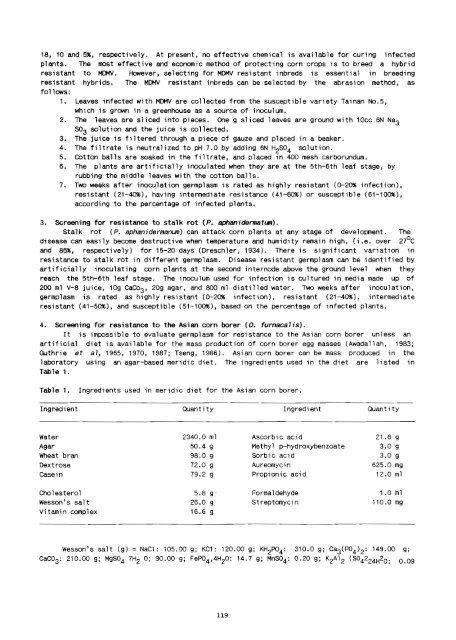Proceedings of the Fifth Asian Regional Maize Workshop - Search ...
Proceedings of the Fifth Asian Regional Maize Workshop - Search ...
Proceedings of the Fifth Asian Regional Maize Workshop - Search ...
Create successful ePaper yourself
Turn your PDF publications into a flip-book with our unique Google optimized e-Paper software.
18, 10 and 5%, respectively. At present, no effective chemical is available for curing infected<br />
plants. The most effective and economic method <strong>of</strong> protecting corn crops is to breed a hybrid<br />
resistant to MDMV. However, selecting for MDMV resistant inbreds is essential in breeding<br />
resistant hybrids. The MDMV resistant inbreds can be selected by <strong>the</strong> abrasion method, as<br />
follows:<br />
1.<br />
2.<br />
3.<br />
4.<br />
5.<br />
6.<br />
7.<br />
Leaves infected with MDMV are collected from <strong>the</strong> susceptible variety Tainan No.5,<br />
which is grown in a greenhouse as a source <strong>of</strong> inoculum.<br />
The leaves are sliced into pieces. One g sliced leaves are ground with 10cc 6N Na 3<br />
S03 solution and <strong>the</strong> juice is collected.<br />
The juice is filtered through a piece <strong>of</strong> gauze and placed in a beaker.<br />
The filtrate is neutralized to pH 7.0 by adding 6N H 2<br />
S0 4<br />
solution.<br />
Cotton balls are soaked in <strong>the</strong> filtrate, and placed in 400 mesh carborundum.<br />
The plants are artificially inoculated when <strong>the</strong>y are at <strong>the</strong> 5th-6th leaf stage, by<br />
rubbing <strong>the</strong> middle leaves with <strong>the</strong> cotton balls.<br />
Two weeks after inoc~lation germplasm is rated as highly resistant (0-20% infection),<br />
resistant (21-40%), having intermediate resistance (41-60%) or susceptible (61-100%),<br />
according to <strong>the</strong> percentage <strong>of</strong> infected plants.<br />
3. SCreening for resistance to stalk rot (P. aphanidermatl.l1l).<br />
Stalk rot (P. aphanidermanum) can attack corn plants at any stage <strong>of</strong> development. The<br />
disease can easily become destructive when temperature and humidity remain high, (i.e. over 27 0 C<br />
and B6%, respectively) for 15-20 days (Dreschler, 1934). There is significant variation in<br />
resistance to stalk rot in different germplasm. Disease resistant germplasm can be identified by<br />
artificially inoculating corn plants at <strong>the</strong> second internode above <strong>the</strong> ground level when <strong>the</strong>y<br />
reach <strong>the</strong> 5th-6th leaf stage. The inoculum used for infection is cultured in media made up <strong>of</strong><br />
200 ml V-B juice, 10g caCo 3<br />
, 20g agar, and BOO ml distilled water. Two weeks after inoculation,<br />
germplasm is rated as highly resistant (0-20% infection), resistant (21-40%), intermediate<br />
resistant (41-50%), and susceptible (51-100%), based on <strong>the</strong> percentage <strong>of</strong> infected plants.<br />
4. SCreening for resistance to <strong>the</strong> <strong>Asian</strong> corn borer (0. furnaca7is).<br />
It is impossible to evaluate germplasm for resistance to <strong>the</strong> <strong>Asian</strong> corn borer unless an<br />
artificial diet is available for <strong>the</strong> mass production <strong>of</strong> corn borer egg masses (Awadallah, 1983;<br />
Guthrie et al, 1965, 1970, 1987; Tseng, 1986). <strong>Asian</strong> corn borer can be mass produced in <strong>the</strong><br />
laboratory using an agar-based meridic diet. The ingredients used in <strong>the</strong> diet are listed in<br />
Table 1.<br />
Table 1.<br />
Ingredients used in meridic diet for <strong>the</strong> <strong>Asian</strong> corn borer.<br />
Ingredient Quantity Ingredient Quanti ty<br />
Water 2340.0 ml Ascorbic acid 21.6 9<br />
Agar 50.4 g Methyl p-hydroxybenzoate 3.0 9<br />
Wheat bran 98.0 9 Sorbic acid 3.0 9<br />
Dextrose 72.0 9 Aureomycin 625.0 mg<br />
Casein 79.2 9 Propionic acid 12.0 ml<br />
Cholesterol 5.8 g' Formaldehyde 1.0 ml<br />
Wesson's salt 26.0 9 Streptomycin 110.0 mg<br />
Vitamin complex 16.6 9<br />
Wesson's salt (g) = NaC1: 105.00 g; KC1: 120.00 g; KH 2<br />
P0 4<br />
: 310.0 g; Ca 3 (P0 4<br />
)2: 149.00 g;<br />
CaC0 3 : 210.00 g; MgS0 4 7H 2 0; 90.00 g; FeP0 4 ,4H 2 0: 14.7 g; MnS0 4 : 0.20 g; K 2 A1 2 (S04224H20: 0.09<br />
119

















